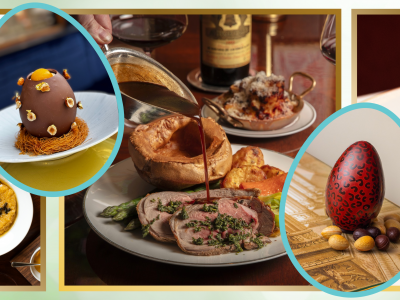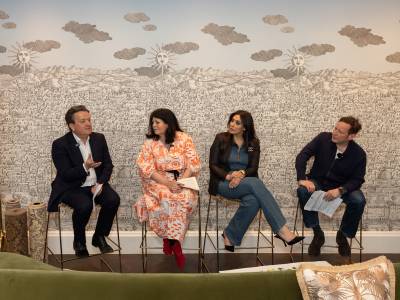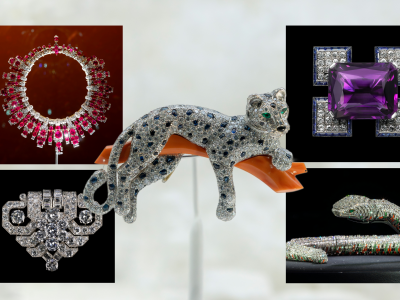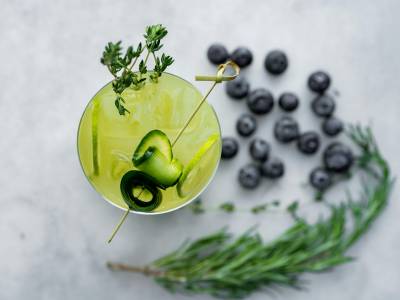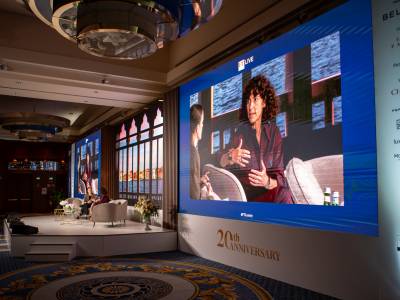All You Need is Love: Yoko Ono at Tate Modern
15th February 2024
‘Yoko Ono: Music of the Mind’ is the largest UK retrospective of the artist and activist, combining Yoko Ono’s multi-disciplinary work from the 1950s to recent works, some unseen. Expect an immersive experience, with performance, film, ‘instructions’ and plenty of visitor participation. Lisa Barnard reviews the ground-breaking Yoko Ono Exhibition at Tate Modern and finds it resonates in 2024

Yoko Ono is big on ‘instructions’. But she does not dictate. Stretching across a wall of the Yoko Ono exhibition at Tate Modern are 150 typescripts from her foundational book “Grapefruit” 1964 – a Do-It-Yourself oeuvre of 200 participatory ‘instructions’ that she conceived over a period of ten years and was self-published in 1964. This is the first time so many have been displayed together and they form a central theme of the exhibition. They are short in text and are inspired by the form of Japanese haikus and Koan riddles. Visitors are invited to step on a painting, carry a bag of peas, perform inside a bag, put our shadows together, hammer a nail, play a game of chess, celebrate our mothers, cough for a year and share our wishes and dreams.
“A dream you dream alone is only a dream. A dream you dream together is reality.”

Why a Yoko Ono Exhibition at Tate Modern in London?
Let's not beat about the bush. Most people have some view on Yoko Ono and not all are positive. She has caused controversy, she comes with 'Beatles Baggage' and you might not agree with all her views. If you are under a certain age you might not have even have heard of her. But there is a reason to visit this exhibition about a living 91-year old artist. Her invitation is to make up your own mind, and get involved if you are willing. My view is that this exhibition could could not be more relevant in 2024,
Yoko Ono’s Exhibition at Tate Modern is the most comprehensive retrospective of her works shown in the U.K. As Karin Hindsbo, Director of Tate Modern, commented at the press opening I attended: “Not only has Yoko Ono been a trailblazing figure in early conceptual film and performance art, but also a celebrated musician and a tireless campaigner for world peace. Today she's firmly established as a cultural icon whose radical strategies and collaborations continue to resonate with new generations of artists and musicians. We thank her for the gift of her expansive and transformative practice, a practice which continues to unite people around the world and which like a wish or a whisper, touches each one of us.”
YOKO ONO Grapefruit 'Instructions'
Yoko invites us to use our imaginations and interpret in any way we’d like. So while instructional, “Grapefruit” is not directional. It’s an ongoing invitation to collaborate. Tate Modern, in its staging of this immersive exhibition in the spacious monochrome galleries of, has put the invitation to participate and self-expression at the heart of its curatorial approach. Cloud piece. Imagine the clouds dripping. Dig a hole in your garden to put it in. (1961) “Smell piece. Send the smell of the moon.” (1953). The sky is often a metaphor for peace, freedom and infinity. As a child fleeing Tokyo in World War 11, Yoko found solace in the constant presence of the sky.

As the show’s curator Juliet Bingham expressed it: “It’s an invitation here to participate, to use her instructions, her art scores, as a way to guide visitors through the exhibition. And she really gave an open invitation, a kind of DIY way to access work.
Assistant curator Andrew de Brun added: “It was really important for us as a curatorial team to make sure that every room in the show had that element of participation. Every room has an element of audio, of moving image, so that we could really communicate the multidisciplinary nature of her practise at different stages throughout career. So there is a sense of liveness in every room that visitors can enjoy and people can be very active and creative participants in the work and collectively make art artworks together.”

The exhibition broadly follows the chronological path of 70 years of this artist-activist, but this is no history lesson. The journey starts in the late 50s with Yoko’s deepening involvement in the avant-garde art and music scene in Tokyo, Kyoto and New York, initially with her lover, Toshi Ichiyanagi, the Japanese composer and pianist, with whom she eloped to New York in 1956, both aged 23.
Chambers Street Loft - Yoko Ono
A highlight is a reel of archive stills, many just digitised and hitherto unseen, of the “Chambers Street Loft Series”. Yoko signed a lease on this downtown loft in Chamber Street in New York and in her typical generosity of spirit invited artists and performers – music, dance, poetry, art – to participate. This provided a forum for avant-garde artists and choreographers to express experimental performance works, whether collaborating with composer John Cage or art collector Peggy Guggenheim or unknown artists in various disciplines. We see Yoko wearing a cardboard head mask, participating as a spectator with her own idiosyncratic viewpoint.

We witness Yoko's contributions to the radical Fluxus movement, which spread art anarchy around the globe, through to her London period when she met John Lennon and embarked on their joined symbolic activist activity, including their famous bed-ins and revolutionary Acorn Event in Coventry.
The exhibition is serious in purpose, but has accents of irreverent humour. You are greeted by the artist as soon as you step foot into the exhibition: “Hello this is Yoko” in a piece of audio “Telephone Piece”. The initially banned ‘Film No 4 (Bottoms)’ (1966-7) zooms into 200 jiggling bottoms across the artworld, or should we say ‘arse-world’? Unconnected in the lavatorial department but equally disconcerting, is audio of ‘Toilet Flush’ in Room 1.

Visitor Participation in Yoko Ono Exhibition
Visitors can participate in “White Chess Set”, which only features white chess pieces on a board of white squares. The deeper significance is conveyed through the instruction: “For playing as long as you can remember where all your pieces are”. Once the game begins, the pieces merge until they eventually become indistinguishable. Eventually you lose the plot.
Or you are invited to "put your shadows together until they become one". Relating to an instruction in "Garepfruit" in 1964, a projector allows you to trace the outline of your companion (or another visitor) as part of the creative project.

An important part of Yoko Ono’s practise was about changing the relationship between the artist and the viewer. “Cut Piece” is a remastered black and white film where Yoko sits on a stage wearing her best suit with a pair of scissors in front of her and invites members of the audience to snip off her clothes. This was first performed in Tokyo and Kyoto and it’s an opportunity to observe the artist today at close-up and personal, almost as a voyeur through the eyes of voyeurs participating.

As Bingham comments: “The invitation was for the audience members to come and cut off her clothing and take a keepsake away with them. So not only was she making herself quite vulnerable, but really, she was inverting the role of artist and performer. So, in the history of performance work, it's a really pivotal piece.”

As Yoko’s art and ideas developed, so could she use her platform to advocate for peace and humanitarian campaigns and amplify her messages. In a world which continues to be beset by conflict, whether Ukraine, Gaza or civil wars, this exhibition will resonate in 2024 and beyond. Already the Wishing Trees at the entrance to the exhibition are adorned with hundreds of messages requesting peace and love, the blue pens have been busy in ‘Add Colour’ room and daughters and sons, including this writer, have written odes to their mothers in my “My Mommy is Beautiful”. So did I.

Yoko Ono turns 91 this week. Her Studio in New York was involved in the planning of the exhibition at all stages, although Tate Modern has undoubtedly moulded this with their own stamp of interpretation. Yoko is not travelling overseas, so there is no plan for her to visit the exhibition. But she will be happy, we hope, to know that her creative output will continue to grow with each visitor and make a difference. I look forward to visiting when it closes to see what has been created.
Yoko Ono: Music of the Mind, Tate Modern, 15 February- 1 September 2024

